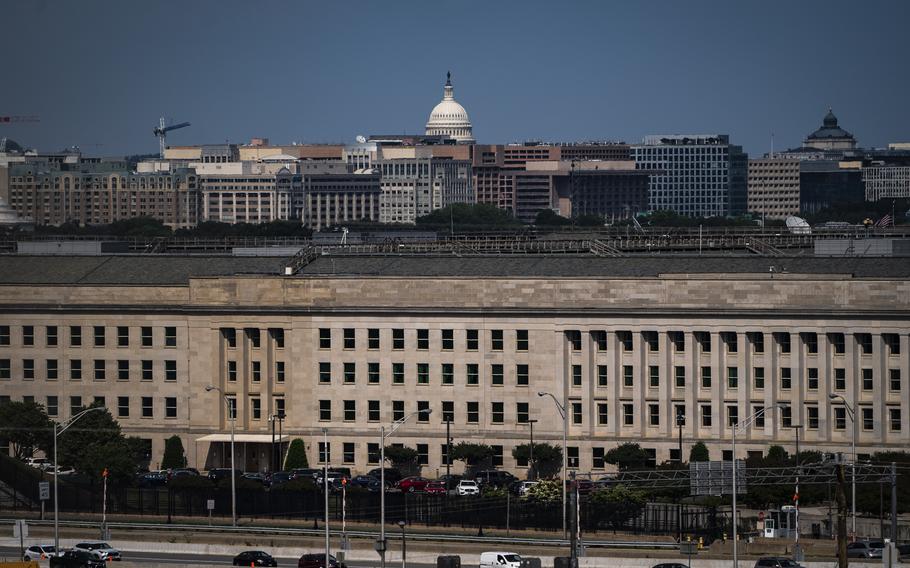
A view of the Pentagon. (Jabin Botsford/The Washington Post)
A key supplier to the Pentagon and U.S. intelligence agencies is building a $20 million supercomputer with buzzy chipmaker Nvidia to speed deployment of artificial intelligence capabilities across the U.S. federal government, the MITRE think tank said Tuesday.
MITRE, a federally funded, not-for-profit research organization that has supplied U.S. soldiers and spies with exotic technical products since the 1950s, says the project could improve everything from Medicare to taxes.
“There’s huge opportunities for AI to make government more efficient,” said Charles Clancy, senior vice president of MITRE. “Government is inefficient, it’s bureaucratic, it takes forever to get stuff done. … That’s the grand vision, is how do we do everything from making Medicare sustainable to filing your taxes easier?”
This AI project is an example of the flurry of activity prompted by the Biden administration’s all-of-government push to ensure the United States remains the world’s leading AI power. Biden signed an executive order in October that ordered accelerated research and deployment of AI across federal agencies, as China makes efforts to catch up.
The MITRE supercomputer will be based in Ashburn, Va., and should be up and running late this year.
MITRE was spun out of a Massachusetts Institute of Technology lab in 1958 and is part of a network of Pentagon-funded research and development centers set up in the early years of the Cold War that also includes Rand and the Fermi National Accelerator Laboratory in Batavia, Ill.
For decades, MITRE has been a supplier of surveillance, communications and cybersecurity technologies to the Pentagon and U.S. intelligence agencies. “We go way beyond what people would typically call IT,” is how a former MITRE chief executive described their research to Forbes magazine, which reported its projects included a prototype tool that could hack smartwatches and software for the FBI that can capture fingerprints from photos of suspects’ hands on social media websites.
Other recent MITRE projects include technology to counter GPS interference, a study on pathogens in Arctic permafrost and a small drone for the U.S. Navy designed to operate autonomously at sea.
Among MITRE’s funding agencies are the departments of Defense, Homeland Security, Commerce and Treasury, as well as the Internal Revenue Service, the Federal Aviation Administration, and the Social Security Administration. The think tank has 9,000 employees — more than Nintendo or Airbnb — and booked $2.2 billion in revenue in 2022. Clancy said half their R&D funds are currently devoted to AI.
Clancy said the planned supercomputer will run 256 Nvidia graphics processing units, or GPUs, at a cost of $20 million. This counts as a small supercomputer: The world’s fastest supercomputer, Frontier in Tennessee, boasts 37,888 GPUs, and Meta is seeking to build one with 350,000 GPUs. But MITRE’s computer will still eclipse Stanford’s Natural Language Processing Group’s 68 GPUs, and will be large enough to train large language models to perform AI tasks tailored for government agencies.
Clancy said all federal agencies funding MITRE will be able to use this AI “sandbox.”
“AI is the tool that is solving a wide range of problems,” Clancy said. “The U.S. military needs to figure out how to do command and control. We need to understand how cryptocurrency markets impact the traditional banking sector. … Those are the sorts of problems we want to solve.”
The contract is the latest success for Nvidia, which is riding high on the AI boom. The Santa Clara, Calif.-based chipmaker is the world’s leader in designing the GPUs used to train advanced AI models, and there has been a global mad scramble for its chips. Nvidia’s stock price is up more than 200 percent from a year earlier.
Vice president of federal for Nvidia, Anthony Robbins, said that the AI sandbox could help the U.S. government with tasks ranging from securing infrastructure against cyberthreats to the IRS cracking down on fraud to helping other agencies roll out chatbots and digital assistants.
“This is a platform by which MITRE can train these large language models,” he said. “You can’t do this important AI work if you don’t have this infrastructure.”
The MITRE-Nvidia AI project is one of a spate of initiatives since Biden’s AI executive order. Silicon Valley giants, defense contractors and universities are all scrambling for a flood of AI contracts.
Graham Gilmer, senior vice president for defense contractor Booz Allen, which is also supplying AI products to the Defense Department and other federal agencies, said there’s been a lot of activity since the executive order, and that the deployment of these AI technologies across the government will probably continue through the decade.
“It’s certainly a major shift that we know all of government is going to have to undertake,” he said.
Other federal AI projects are also underway. The National Science Foundation launched an AI research program in January with companies like Amazon, Google and OpenAI as partners along with agencies like the Defense Advanced Research Projects Agency.
The Pentagon has begun studying military applications of generative AI in a program called “Task Force Lima.”
The National Institute of Standards and Technology has also launched a U.S. AI Safety Institute that is researching AI risks with the input of industry.